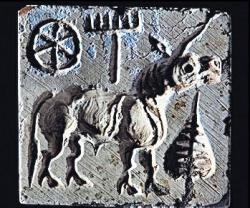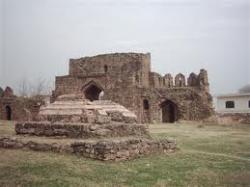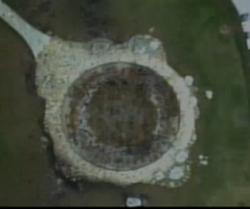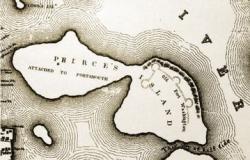INSTITUT SUPERIEUR D'ANTHROPOLOGIE
INSTITUTE OF ANTHROPOLOGY
ONLINE COURSES / COURS A DISTANCE
SPRING TERM : APRIL 2014
REGISTER NOW
INDE –  Hanumangarh - The Archaeological Survey of India (ASI) last week unearthed a Harappan seal from Karanpura in the Hanumangarh district of Rajasthan. “The seal consists of two Harappan characters, with a typical unicorn as the motif and a pipal leaf depicted in front of an animal. There is a knob behind theseal" says VN Prabhakar, superintending archaeologist, who led the ASI team. Maintaining that the discovery ‘confirms’ that the site belongs to the mature Harappan period, the time when the civilization was at its peak (2600 BC to 1900 BC), he said: “A cubicle chert weight was also unearthed in a different house complex. Both the seal and the weight establishes that the people of this area participated in commercial transactions.”We are collecting charcoal sample to date the habitation through radio carbon dating, he said. The excavation at Karanpura, which started in 2012, had earlier brought to light two broad cultural levels, namely the early and the mature Harappan age. Besides artefacts, house complexes built of mud bricks of early Harappan and mature Harappan periods were also unearthed.
Hanumangarh - The Archaeological Survey of India (ASI) last week unearthed a Harappan seal from Karanpura in the Hanumangarh district of Rajasthan. “The seal consists of two Harappan characters, with a typical unicorn as the motif and a pipal leaf depicted in front of an animal. There is a knob behind theseal" says VN Prabhakar, superintending archaeologist, who led the ASI team. Maintaining that the discovery ‘confirms’ that the site belongs to the mature Harappan period, the time when the civilization was at its peak (2600 BC to 1900 BC), he said: “A cubicle chert weight was also unearthed in a different house complex. Both the seal and the weight establishes that the people of this area participated in commercial transactions.”We are collecting charcoal sample to date the habitation through radio carbon dating, he said. The excavation at Karanpura, which started in 2012, had earlier brought to light two broad cultural levels, namely the early and the mature Harappan age. Besides artefacts, house complexes built of mud bricks of early Harappan and mature Harappan periods were also unearthed.
http://www.hindustantimes.com/news-feed/science/harappan-era-seal-found-in-rajasthan/article1-1178990.aspx
ROYAUME UNI - Edinburgh - Archaeologists have found two bodies dating back to the Bronze Age buried beneath the playground of a primary school. The prehistoric discovery at Victoria Primary School in Edinburgh came during a routine site survey to extend the school. The remains, said to be in "pretty good condition", have given experts hope that there may be more ancient burial sites nearby. John Lawson, archaeology officer at Edinburgh council, said: "It was completely unexpected to find them in that location. This is the very start of something. It's an initial discovery and further excavations will provide us with answers on who they are. "They have not been fully excavated, but the style of burial is common for the Bronze Age. The adults are in a foetal position with their knees up against their chest - it's a definite style which is very indicative of a prehistoric burial." The excavations are at an early stage but experts think the bodies may be dated "between 200 and 300 years either side of 2000BC". It is too early to say how the individuals died, but work will continue to examine their remains and the three ft-long pits in which they were found along with shards of pottery.
http://www.heraldscotland.com/news/home-news/bronze-age-find-under-school.23342602
PAKITAN -  Rawat Fort - After withstanding the onslaught of mighty armies for centuries, the 16th century Rawat Fort has fallen to the modern day invaders - the land grabbers. Built in 1546, the once imposing fort just 18 kilometres away from the garrison city of Rawalpindi today presents a picture of urban vandalism, not the unique heritage site it is listed in archaeology manuals. Encroachers have invaded from all four sides, mocking at the notice board of the Archaeology Department, warning that, “This site is protected under the Antiquities Act 1975. New construction within 200 feet of the Fort is prohibited and is punishable by imprisonment and fine.” But encroachers have built houses cheek-to-cheek with the wall of the fort.
Rawat Fort - After withstanding the onslaught of mighty armies for centuries, the 16th century Rawat Fort has fallen to the modern day invaders - the land grabbers. Built in 1546, the once imposing fort just 18 kilometres away from the garrison city of Rawalpindi today presents a picture of urban vandalism, not the unique heritage site it is listed in archaeology manuals. Encroachers have invaded from all four sides, mocking at the notice board of the Archaeology Department, warning that, “This site is protected under the Antiquities Act 1975. New construction within 200 feet of the Fort is prohibited and is punishable by imprisonment and fine.” But encroachers have built houses cheek-to-cheek with the wall of the fort.
http://thepeninsulaqatar.com/news/pakistanafghanistan/271158/16th-century-rawat-fort-falls-to-rawalpindi-land-grabbers
USA –  Miami - Archaeologists say an extensive Native American village they've uncovered in downtown Miami is one of the most significant prehistoric sites in the United States. The Miami Herald reports that over the past several months, archaeologists have dug up eight large circles comprised of uniformly carved holes in the limestone. They think these are foundation holes for Tequesta Indian dwellings that could date back 2,000 years.
Miami - Archaeologists say an extensive Native American village they've uncovered in downtown Miami is one of the most significant prehistoric sites in the United States. The Miami Herald reports that over the past several months, archaeologists have dug up eight large circles comprised of uniformly carved holes in the limestone. They think these are foundation holes for Tequesta Indian dwellings that could date back 2,000 years.
http://www.wptv.com/dpp/news/state/city-of-miami-developer-in-quandary-over-prehistoric-find?#ixzz2sNAzhX31
VIDEO = http://www.nbcmiami.com/news/local/Prehistoric-Native-American-Village-Found-in-Downtown-Miami-243474241.html?
USA –  Peirce Island - More than 12,000 artifacts were unearthed from hundreds of test pits dug around Portsmouth's Peirce Island last fall as part of a federally mandated archaeological exploration to precede federally mandated upgrades to the city's wastewater treatment plant. The goal of the archaeological survey is to determine whether "archaeological resources" are located in areas planned for permanent new structures, or in areas to be used for temporary staging or storage during construction to upgrade the sewer plant. News about the archaeological findings is preliminary and some details are being kept secret by law. But one highlight disclosed last week is that two "dump areas," with artifacts from the Revolutionary War and the War of 1812, were discovered and are being described as "important." The two areas, known as "middens," were discovered outside a fence around the treatment plant and must be isolated and protected during future construction, according to the preliminary memo. Another piece of news in the early report is that nothing of "historical significance" was found inside the fenced area. According to Portsmouth Deputy Public Works Director Brian Goetz, that means the archaeological findings will not impact planned upgrades to the plant. Meanwhile, the Peirce Island Committee is calling for further archaeological exploration in an area where the Revolutionary War-era Fort Washington — a rolling series of earthen berms — was bulldozed prior to construction of the existing treatment plant.
Peirce Island - More than 12,000 artifacts were unearthed from hundreds of test pits dug around Portsmouth's Peirce Island last fall as part of a federally mandated archaeological exploration to precede federally mandated upgrades to the city's wastewater treatment plant. The goal of the archaeological survey is to determine whether "archaeological resources" are located in areas planned for permanent new structures, or in areas to be used for temporary staging or storage during construction to upgrade the sewer plant. News about the archaeological findings is preliminary and some details are being kept secret by law. But one highlight disclosed last week is that two "dump areas," with artifacts from the Revolutionary War and the War of 1812, were discovered and are being described as "important." The two areas, known as "middens," were discovered outside a fence around the treatment plant and must be isolated and protected during future construction, according to the preliminary memo. Another piece of news in the early report is that nothing of "historical significance" was found inside the fenced area. According to Portsmouth Deputy Public Works Director Brian Goetz, that means the archaeological findings will not impact planned upgrades to the plant. Meanwhile, the Peirce Island Committee is calling for further archaeological exploration in an area where the Revolutionary War-era Fort Washington — a rolling series of earthen berms — was bulldozed prior to construction of the existing treatment plant.
http://www.seacoastonline.com/apps/pbcs.dll/article?AID=/20140202/NEWS/402020345/-1/NEWSMAP